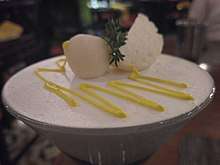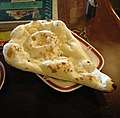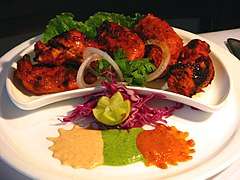Ras malai
Ras malai or rossomalai is a dessert originating from the eastern regions of the Indian subcontinent, possibly Bengal. The name ras malai is the Hindi[2] cognate of Bengali: rosh, meaning "juice", and malai, meaning "cream". It has been described as "a rich cheesecake without a crust".[3] The sweet is of Bengali origin; according to K.C. Das Grandsons, it was invented by K.C. Das.[1] It is also a popular dessert in Pakistan.[4]
| Alternative names | Rossomalai, Roshmolai |
|---|---|
| Course | Dessert |
| Region or state | Bengal region of the Indian subcontinent |
| Associated national cuisine | India, Bangladesh, Pakistan |
| Created by | Possibly K. C. Das[1] |
| Serving temperature | Cold |
| Main ingredients | Chhena, malai, sugar |
| Variations | Comilla's rosho malai |
| Similar dishes | Rasgulla |
Origin and etymology
It is believed to have originated somewhere in Eastern India, presumably in the Bengal region.[5] The K.C. Das Grandsons confectioners claims that it was invented by K.C. Das, but this claim is said to be "impossible to verify".[1]
According to The Diner's Dictionary: Word Origins of Food and Drink published by Oxford University Press "The term comes from Hindi raś 'juice', and malai 'cream'.[6]
Ingredients
Ras malai consists of flattened balls of chhana soaked in malai (clotted cream) flavoured with cardamom. Milk is boiled and a bit of vinegar or lime juice is added to split it. The whey is discarded and the milk solids are drained, cooled and kneaded into a dough. The dough is divided into small balls and the balls are cooked in hot water with a bit of rose water added. The balls are then cooked in milk with saffron, pistachios and kheer as stuffing.
Variations

Different types of rasmalai can be found in different areas. In Dhaka and Rangpur, the rasmalais are similar in shape to the rasgullas.[7]
See also
References
- Michael Krondl (2011). Sweet Invention: A History of Dessert. Chicago Review Press. pp. 71–72. ISBN 978-1-55652-954-2.
- Ayto, John (2012). The Diner's Dictionary: Word Origins of Food and Drink. OUP Oxford. p. 301. ISBN 978-0-19-964024-9. Retrieved 22 April 2020.
- Catherine Soanes, Angus Stevenson (2003). Oxford Dictionary of English (2nd ed.). Oxford University Press. p. 1459. ISBN 0198613474.
- Shavelson, Paul (2015). Flat Food, Flat Stomach: The Law of Subtraction. Post Hill Press. ISBN 978-1-61868-932-0. Retrieved 22 April 2020.
- http://www.indiamarks.com/ras-malai-a-milk-based-dessert-india/
- Ayto, John (2012). ras-mal%C4%81i%20is%20the%20urdu%7CHindi&f=false The Diner's Dictionary: Word Origins of Food and Drink. OUP Oxford. p. 301. ISBN 9780199640249.
- Mahmud Nasir Jahangiri (2012). "Sweetmeats". In Sirajul Islam and Ahmed A. Jamal (ed.). Banglapedia: National Encyclopedia of Bangladesh (Second ed.). Asiatic Society of Bangladesh.


